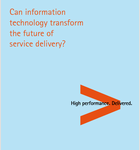
Information technology (IT) is a powerful tool that can be a liberating force for social security agencies historically bound by paper. Looking back, a lack of IT has shaped the current landscape in social security: siloed product delivery, regional focus, demand for paper-based evidence and a reliance on human decision-making.
The result? Processes and products designed for the organization, not for those who need the help. And for the organization, a lot of redundancy and inefficiency has been built in from the start, and grown in layers over time.
Redesigning social security without the organizational, product and process constraints imposed by paper is how information technology can radically transform social security delivery. There are significant risks where this is not done correctly—opening doors for increased fraud or excluding those most in need of help. There are also huge opportunities where the risks are mitigated and the agency is able to rethink the whole delivery of social security.